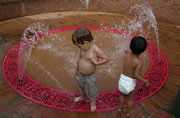Water Play Areas & Interactive Fountains
Print-and-Go Fact Sheet
Keeping Water Play Areas / Interactive Fountains Clean

Water play areas (may also be called an interactive fountain, wet deck, splash pad, spray pad, or spray park) are becoming more common. People may not realize that although there is no standing water in these attractions, the spray water will rinse any contaminants (for example, diarrhea, vomit, and dirt) down into the water holding area and be sprayed again. In other words, the water is recycled through the system. As a result, it is possible for the water to become contaminated and make people sick.
Because water play areas / interactive fountains are relatively new, health departments may not have specific requirements for how this water is treated. The water play area / interactive fountain may have been built without a system to make sure that contaminants are disinfected and filtered. Caregivers and children should follow the Steps of Healthy Swimming when using a water play area to help protect themselves and others.
Outbreaks Associated with Water Play Areas / Interactive Fountains

During the summer of 2005, an outbreak of cryptosporidiosis occurred at Seneca Lake State Park in New York. Over 1,700 people may have been infected with 425 laboratory-confirmed cases of cryptosporidiosis and 1,374 probable cases were identified 1. Cryptosporidium was traced to the water tanks that supplied the 11,000 square foot wet deck (spraypark). In response, New York passed emergency public health regulations to govern the design and sanitation of such attractions statewide.
A 1999 outbreak of diarrheal illness affected 44% of patrons (an estimated 4,800 people) who visited a new interactive fountain in a beachside park 2. When officials from the health department inspected the interactive fountain, they found that the water drained from the play area into an underground reservoir for recirculation. The problem turned out to be a result of inadequate chlorination and the lack of a filtration system. The chlorine tablet erosion feeder had not been filled for weeks and the designers did not include a filtration system.
References
- Shaffzin JK, Keithly J, Johnson D, Sackett D, Hoefer D, Hoyt L, Lurie M, Teal A, Rosen B, Tavakoli N, St. George K, Braun-Howland E, Wallace B . Large Outbreak of Cryptosporidiosis Associated with a Recreational Water Spraypark—New York 2005. 55th Annual Epidemic Intelligence Service Conference, 2006.
- CDC. Outbreak of gastroenteritis associated with an interactive water fountain at a beachside park —Florida, 1999. MMWR Morb Mortal Wkly Rep. 2000;49(25):565-8.
- Page last reviewed: May 4, 2016
- Page last updated: May 4, 2016
- Content source:


 ShareCompartir
ShareCompartir
